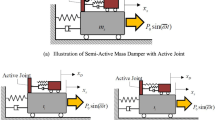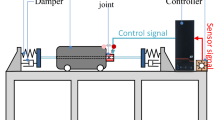Abstracts
This paper presents an experimental investigation on semi-active seismic response control of a multistory building with a podium structure using multiple magnetorheological (MR) dampers manipulated by a logic control algorithm. The experiments are performed in three phases on a seismic simulator with a slender 12-story building model representing a multi-story building and a relatively stiff 3-story building model typifying a podium structure. The first phase of the investigation is to assess control performance of using three MR dampers to link the 3-story building to the 12-story building, in which seismic responses of the controlled two buildings are compared with those of the two buildings without any connection and with rigid connection. The second phase is to investigate reliability of the semi-active control system and robustness of the logic control algorithm when 2 out of 3 MR dampers fail and when the electricity supply to MR dampers is completely stopped. The last phase is to examine sensitivity of semi-active control performance of two buildings to change in ground excitation. The experimental results show that multiple MR dampers with the logic control algorithm can achieve a significant reduction in seismic responses of both buildings. The proposed semi-active control system is of high reliability and good robustness.
Similar content being viewed by others
References
Carlson JD and Spencer BF Jr (1996), “Magnetorheological Fluid Dampers: Scalability and Design Issues for Application to Dynamic Hazard Mitigation,”Proc. 2nd Int. Workshop on Structural Control, Hong Kong University of Science and Technology, Hong Kong, pp. 99–109.
Carlson JD, Catanzarite DM and St. Clair KA (1996), “Commercial Magneto-rheological Fluid Devices,”Int. J. Modern Phys. B,10(23/24): 2857–2865.
Chen J, Qu WL and Zhang NL (2002), “Structural Control Based on PanBoolean Algebra,”Proc. of the 6 th World Multi-Conference on Systematics, Cybernetics, and Informatics, Florida, USA, pp. 199–202.
Dyke SJ, Spencer BF Jr, Sain KM and Carlson JD (1998), “An Experimental Study of MR Dampers for Seismic Protection,”Smart Materials and Structures: Special Issue on Large Civil Structures,7: 693–703.
Dyke SJ, Spencer BF Jr, Sain MK and Carlson JD (1996), “Modeling and Control of Magnetorheological Dampers for Seismic Response Reduction,”Smart Materials and Structures,5: 565–575.
Jansen LM and Dyke SJ (2000), “Semiactive Control Strategies forMRDampers: Comparative Study,”Journal of Engineering Mechanics, ASCE,126(8): 795–803.
Leitmann G (1994), “Semiactive Control for Vibration Attenuation,”Journal of Intelligent Materials, Systems and Structures,5: 841–846.
McClamroch NH and Gavin HP (1995), “Closed Loop Structural Control Using Electrorheological Dampers,”Proc. Am. Control Conf, American Automatic Control Council, Washington, D.C., pp.4173–4177.
Qu WL and Xu YL (2001), “Semi-active Control of Seismic Response of Tall Buildings with Podium Structure Using ER/MR Dampers,”The Structural Design of Tall Buildings,10: 179–192.
Rabinow J (1948), “The Magnetic Fluid Clutch,” AIEE Trans.67: 1308–1315.
Spencer BF Jr, Carlson JD, Sain MK and Yang G (1997a), “On the Current Status of Magnetorheological Dampers: Seismic Protection of Full-scale Structures,”Proc. Am. Control. Conf, American Automatic Control Council, Washington, D.C., pp.458–462.
Spencer BF Jr, Dyke SJ, Sain MK and Carlson JD (1997b), “Phenomenological Model for Magnetorheological Dampers,”Journal of Engineering Mechanics, ASCE,123(3): 230–238.
Whitesitt JE (1995),Boolean Algebra and its Applications, Dover Publications Inc., New York, USA.
Yi F, Dyke SJ, Caicedo JM and Carlson JD (2001), “Experimental Verification of Multi-input Seismic Control Strategies for Smart Dampers,”Journal of Engineering Mechanics, ASCE,127(11): 1152–1164.
Author information
Authors and Affiliations
Corresponding author
Additional information
Supported by: The Hong Kong Polytechnic University under Area of Strategic Development Programme in Structural Control and Intelligent Building; National Natural Science Foundation of China Under Grant NNSF-50038010
Rights and permissions
About this article
Cite this article
Jing, C., Youlin, X., Weilian, Q. et al. Seismic response control of a complex structure using multiple MR dampers: experimental investigation. Earthq. Eng. Eng. Vib. 3, 181–193 (2004). https://doi.org/10.1007/BF02858233
Received:
Accepted:
Issue Date:
DOI: https://doi.org/10.1007/BF02858233




